Silence is golden
This week: What can I do now; Moving inside; Workshop roundup; Wood butchery; Silence is golden;

While I am waiting for the concrete to dry, I have to say that it is nice not having the builders around. No trailing wires, hosepipes or workmen running you over with a speeding wheelbarrow!
The downside is that there are support jacks everywhere, which have to be avoided. These heavy support structures will finally be removed in another two weeks.
I’ve been to my bank in Jelsa this week. The builder asked for a stage payment and everything here is a cash transaction. I like to get there for 8am, when they open.
The town is quiet, parking is not a problem – it’s free until 9am and at this time of year and there are few people about. I can get in, do a supermarket shop, withdraw cash and be back home for 8.30am.

In the garden the miniature Iris have come into flower this week. The purple hue of the flowers shining brightly in the warm spring sunshine, attract early bees and other insects to feed on the nectar.
What can I do now?
Watching concrete dry is slightly less interesting than watching paint dry. Both change colour as they dry, but concrete takes a lot longer to achieve its full strength.
Talking to my friend Cvjetko on Sunday, he told me that there is a formula that is used locally for the drying and hardening process.
For every centimetre of concrete, add a day before the shuttering can be removed.
So with 25 centimeters of concrete in places where the ring beams run, that means 25 days.
That doesn’t mean there is nothing to do. Far from it. there are a lot of small jobs I have been getting on with this week.
First up was to make a cover for the well where the steps will go.
The second phase of building will be the lounge which will form the link between the dining room and the bedrooms.
Knowing this, the builder has left a space, free of concrete where the steps will go. There is no point in filling in an area that will then have to be cut out later.
I used a profile gauge to mark a piece of timber. This is so that I can get as close as possible a fit against the uneven wall.
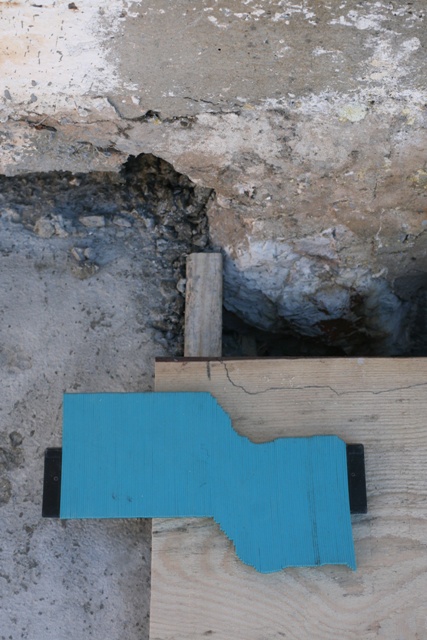
Then I cut the wood to the profile with a jigsaw cutter.
The next job was to screw the covers in place. I like to use screws because they are easier to remove than nails. The TORX screws I now use exclusively are easy to drive in because of the shape of their head and they don’t rust.
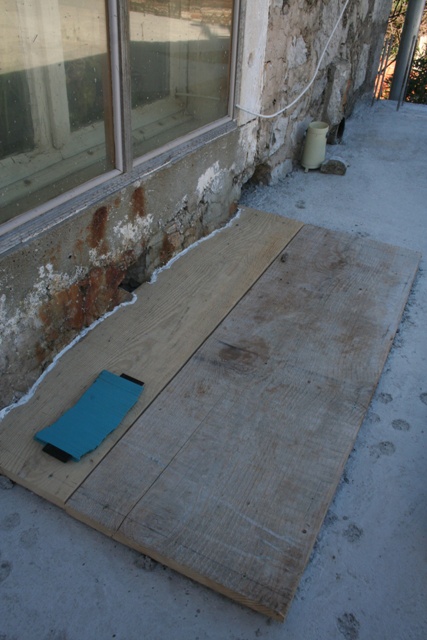
Finally I filled the small remaining gap between the timber cover and the wall with external silicone after fitting.
Moving inside
I have a layout plan for the workshop. I have designed it around an efficient work flow, but also so that it will be easy to keep the workshop clean. There is lots of clear floor space making brushing easy.
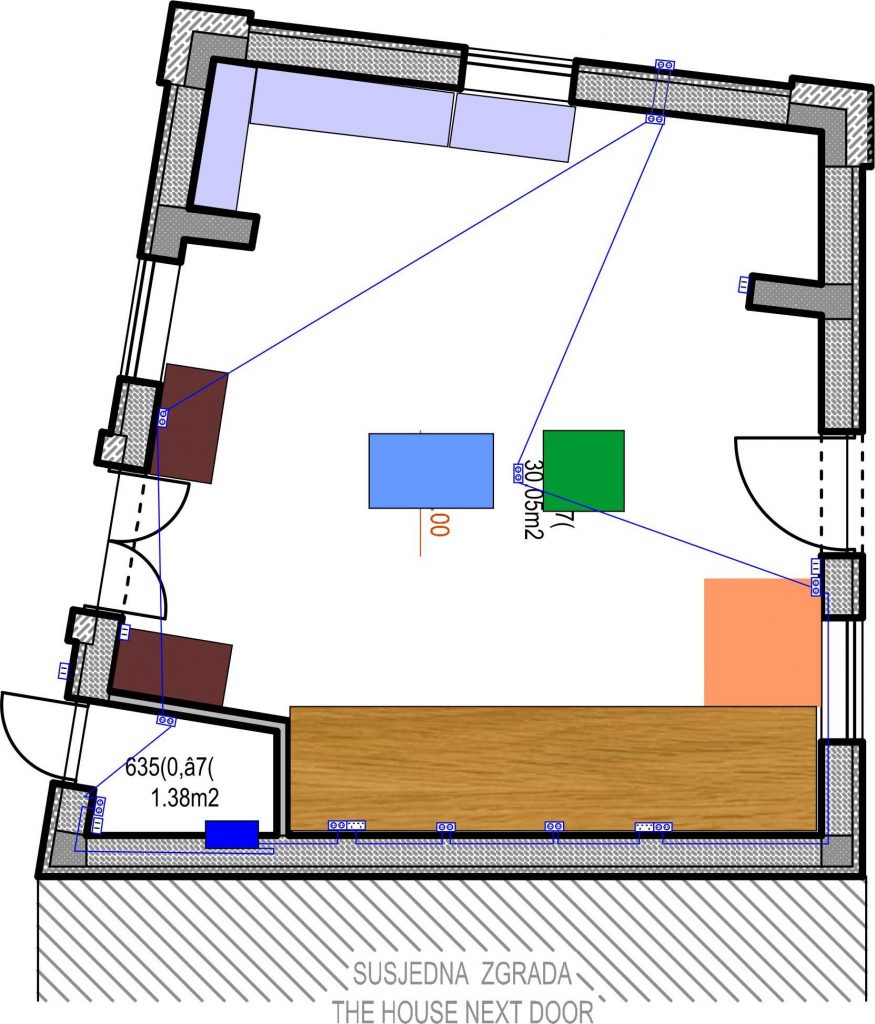
There is a wide central area for woodwork, so it will be easy to remove the sawdust. Around the walls there are various work benches, routing tables and the like. Then there will be plenty of shelving for tools.
Apart from the need for wall sockets, I also have a number of air powered tools. From things like a Sand Blasting cabinet, to windy drills, they run on compressed air.
I have a small wheeled air compressor, but it is noisy when it is in operation. So my plan is to have the compressor outside and the tools inside. But this means a connection will be needed between the two.
You could of course just use a flexible air hose through the door, but I decided that I would install a fixed steel air delivery pipe.
This plan means I can connect the compressor to a point on the wall outside with a snap-on bayonet connector.
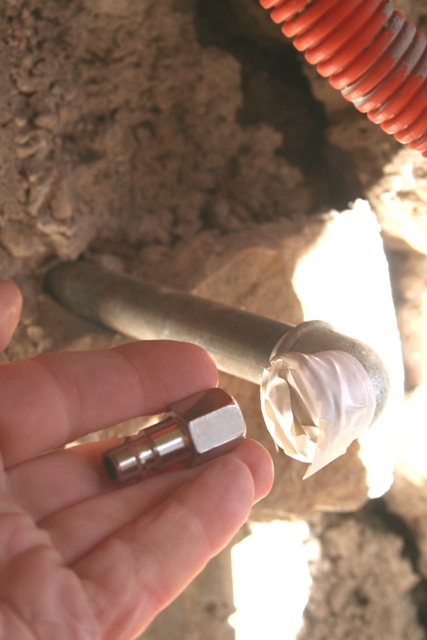
Compressed air will be delivered via a moisture trap, to a point on the wall in the workshop, where I can attach a flexible hose with the tool on the end.

It was less than a mornings work to install the steel pipe. It is a re-purposed steel water pipe with new joints.
I did need to do a little bit of drilling to get a perfect fit, but the job is now done. To protect the pipe, the ends have been covered in tape but the basic elements of the system are all now in place.
Another job has been to run through the power cable for the sockets from the new Consumer Unit. While there was still a gap in the wall, I pushed the conduit and cable through.
Inside the workshop, the old external wall which just rests on the sandstone bedrock, will be filled and supported with more concrete.
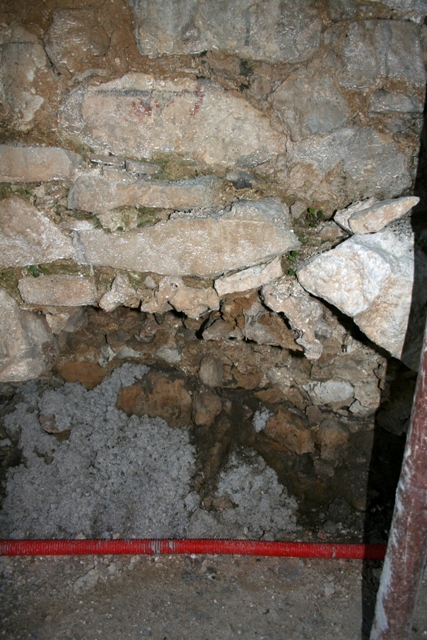
This was the way houses here were built 120+ years ago. Natural outcrops of rock became a building’s firm foundations, once the building was attached to the rock.
The inside workshop walls will be rendered. I will have to wait for all the support jacks and shuttering to be removed before I fit the electrical patress boxes.
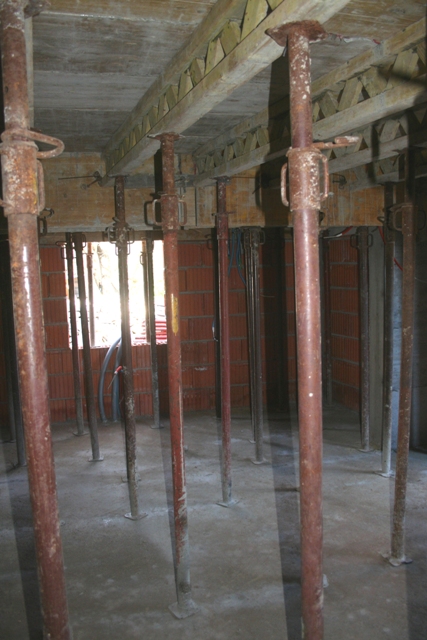
Workshop roundup
I have really neglected the old workshop over the past few months. I have quite a number of meters of shelving, and I use the IKEA SAMLA clear storage boxes throughout for storage.
Although the boxes are all neatly labelled with their contents, not every tool or device had been replaced back in its box after use, so my work bench was somewhat cluttered.
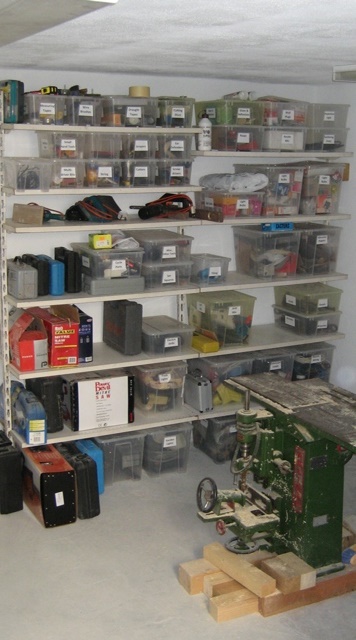
A ‘clear-up’ morning remedied this. All the loose tools and equipment have now been put back into their correct storage containers. I have created some new boxes as well.
Last time I went to IKEA, I bought half a dozen extra boxes, so I have a supply in stock for whenever I need them.
This is all part of the master plan for moving into the new workshop space, once the builders have finished.
However what I have now decided to do is to completely fit out the new building before I move anything.
My original plan was to use the new space once it was complete, to clear the Konoba of storage boxes, so that work could start on converting it into a liveable room.
Then when the Konoba had been completely refurbished, the plan was to move furniture back into the room. It will become a living space instead of storage, and over the summer I would finish the new building.
As the builder will be moving straight onto a new project after he finishes at my Dol house, the imperative to clear the Konoba store has gone.
It would clearly be better to finish the new workshop completely and then think about moving things round. Whilst at the same time, making full use of the enhanced workshop facilities.
Wood Butchery
I own an old craftsman made wooden bench seat which has been in my various gardens over the years. It has travelled around in my container, with the rest of my belongings, since it was built around 1983.
I’ve looked after the seat because it has always been a comfortable place to sit in the sun, with a cup of coffee in the morning.
You could hardly call it an antique, nor is it made out of hardwood. I’ve cared for it over the years, coating the exposed parts with preservative, letting the liquid soak into the joints, of which there are many.
A couple of weeks ago as I sat in the warm sun, with a drink in my hand, there was an ominous crack. I felt the centre seat rail give way under me.
When I checked the rail, it has gone rotten and simply broken at a knot.
I collected some replacement timber this week while I was at the builders merchants. Then I spent a little bit of time on Wednesday afternoon making a new rail.
The new piece needed to precisely match the old. I first ran the cut rail through the Makita Thickness Planer machine, to reduce it to the same dimensions.
I have kept the black japanned domed Pan Head screws which fixed the old rail to the seat. These are the traditional wood screws which have been used throughout the UK for decades.
They showed little sign of corrosion, even after just short of 40 years of being out in all weathers. They have suffered from ice and snow in England and extreme heat and sand in Abu Dhabi.

With the screw holes drilled, I gave the new rail a coat of Sadolin wood preservative, then left it to dry.
I think it is two years since I painted the whole bench with wood preservative. So before fitting the replacement rail, I re-painted the complete bench again.
If you are doing it properly, the painting has to be done in two stages. The underside is painted first and left to dry completely, before I turned the bench over and painted the top.
I’ll leave it now for a few days to properly dry in the sunshine before I next use the bench for its intended purpose.

Silence is golden
Especially at sunset!
A high limestone ridge runs the length of the island of Hvar. Everywhere to the north of the ridge experiences the later than sunrise appearance of the sun in the morning, and its early departure in the evening.
We are now two months past the northern winter solstice and the spring is here. Leaves are appearing on trees, the very first blossom is on the early Almond trees and it has been warm enough in the sun this week for a tee-shirt.
As the days lengthen, it is nice to be able to be out and about longer each day.
I needed to go into Stari Grad to the Builders Merchants for some essential fixings I had run out of. Volat opens early in the morning for builders, then shuts at 13:00 until 16:30, when they open again until 19:30.
Normally I go into town early, but as I was going late in the afternoon, I took a detour via the only permanent fresh water on the island.
On the very northern edge of the Stari Grad plain, there is a small permanent lake called “Dračevica“. There isn’t a translation into English for the name.
The small lake is a stopping place for migrating birds and there are some resident fish, reptiles and turtles.
In winter Dračevica is full, then by the end of summer it has shrunk to just a few small ponds, exposing all the large rocks round its edge.
The belief is that this was an important location for the Illirians and later the Greeks and Romans, because of the dearth of natural fresh water springs on the island.
This week, even though we have not had the normal amount of rainfall for the winter, it is still quite full.
As I arrived my car disturbed what I think was an Oyster Catcher. Certainly a fast flying black and white wader which disappeared at great speed on my approach. There was nothing else on or near the lake.
Waiting for the setting sun to dip behind the southern hills, I was taken by the complete silence.

No other sound. No wind, no birds, no aircraft in the overhead flight-path to Rome, just complete silence.
The quietness was only broken by an occasional “plop” as a fish took some of the thousands of insects which were hovering just above the water.
I watched as the sun dipped down behind the Dugi Rat peak in the south west. The setting sun turning the water to burnished gold.

Once the last rays had gone, I went into Stari Grad to get the supplies I needed. Then it was home through the all enveloping dusk…NRC
One Response
Rick
Nice poetic reflections at the end of the post.